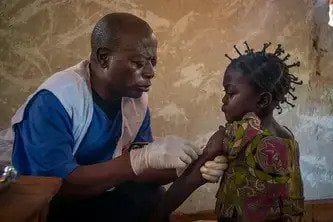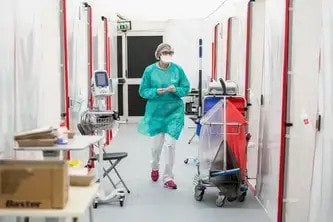New 15-year blueprint to tackle global issues, including health, by 2030
The Sustainable Development Goals (SDGs) under the motto “Leave no one behind” will replace the Millennium Development Goals (MDGs), which have guided development policies, including health, since 2000.
World leaders representing the 193 United Nations Member States will adopt the SDGs at the end of September in New York at a special Summit. The 17 goals and 169 targets will apply to all countries, rich and poor, and will tackle a wide range of global issues, including health, climate change, economic development, human rights and gender equality.
SDGs health and related targets
The aspirations for global health are set out in Goal 3: “Ensure healthy lives and promote wellbeing for all at all ages” and other SDG goals include targets that will impact on health. They include, by 2030:
- end preventable deaths of newborns, children and pregnant women;
- end epidemics such as AIDS, tuberculosis, and malaria;
- guarantee broader access to healthcare, vaccines and medicines;
- end malnutrition;
- Improve hygiene and sanitation;
- Improve emergency response;
- achieve universal health coverage.
The SDGs are worthy aspirations, but as yet there is no clear plan for achieving them. Médecins Sans Frontières (MSF) wants to know how the health targets will become more than just wishful thinking. Why? Because MSF works in more than 60 countries and witness troubling development trends and funding levels that are out of step with people’s health needs and the ambitions for health expressed in the SDGs. This misalignment continues to destroy people’s lives and cripple communities.
Reality Check
Gaps between needs and SDGs health ambitions
- In many countries where MSF works, a shocking number of women are still dying unnecessarily. At present, 38 times as many women die in childbirth in Afghanistan as they do in the United Kingdom. Maternal mortality rates are 178 times higher in Central African Republic than in Japan, and 220 times higher in Chad than in Sweden.
- Once countries are classified as middle-income, they lose international support yet they are home to over 70% of the world's poorest and the highest number of people living with HIV/AIDS, tuberculosis, malaria and non-communicable diseases. Despite their improving economic situation, most cannot cope with the financial cost of these diseases, and their health systems are not able to offer vital care to the poorest and most marginalised.
- There are many countries where people do not seek medical care due to financial barriers or cannot access the medicines they need because they are not available. For example, only one in five people in the world with multi-drug resistant tuberculosis (MDR-TB) are receiving treatment.
- Disease outbreak surveillance, preparation, alert and response are often ill-adapted to local needs and reality.
- Migrants and refugees suffer the medical consequences of the current restrictive policies.
Putting the health gains of the last 15 years at risk
Over the last 15 years, unparalleled resources have been mobilised to save lives and alleviate suffering. New funding sources, including the Global Fund, Gavi and PEPFAR, have resulted in unprecedented financial support for global health. Global health agencies, governments and civil society groups have implemented innovative strategies that have targeted major diseases, helped pay for medicines and health staff, tackled stigma, rolled out effective community-based services and challenged obstructive policies and laws.
The result has been a visible and measurable progress in improving people’s health.
However, these gains are fragile. They must be consolidated and accelerated by continuing with proven approaches and proposing flexible alternatives, or the progress risks being lost.
- An example of this is the global treatment figures for HIV. Although encouraging, there are still many countries where patients are without access to treatment. In the Democratic Republic of Congo, for example, just 17% of those in need of treatment receive it. The roll-out of antiretroviral treatment must be accelerated, and health services must be overhauled to make it easier for people to access and adhere to treatment. Without these steps, global progress in tackling HIV will stagnate.
Inadequate support for research and development (R&D), and lack of access to vaccines and medicines
- Support for R&D on behalf of developing countries is badly needed. Ebola is a prime example of the failure of the global R&D model. MSF’s medical teams did not have treatments, rapid diagnostic tests, or vaccines for the nearly 10,000 people admitted to its Ebola Management Centres, including the 5,200 people with confirmed Ebola diagnosis.
- The cost of the basic package of immunisation is now 68 times more expensive than it was in 2001. This means that in many countries vaccines remain too expensive to be accessible by many governments or humanitarian organisations such as MSF.
- There have been new TB drugs developed, but in many countries these remain unaffordable or unavailable. More needs to be done to address this serious public health emergency.
- Meeting any target to treat hepatitis C will require considerable efforts by governments to reduce the prices of new medicines. At the moment, in the US and in EU countries, medication to treat the hepatitis C virus can often cost as much as US$1,000 per pill, or US$84,000 for a course of treatment.
- Low-income countries should make better use of the trade flexibilities created to improve access to medicines by developing countries (the TRIPS flexibilities), but their ability to do so is under threat by increasingly restrictive new regulations and international trade agreements. India, the pharmacy of the developing world, is under sustained pressure by the US and other high-income countries to stop producing generic medicines and vaccines. If this happens, it will have a serious impact on many countries and MSF’s projects around the world as the cost of medicines and vaccines will rise considerably.
Funding for health is being reduced
- Towards the tail-end of the MDG era, international funding for health has been reducing. Health has been relegated to an economic function rather than an urgent priority. For example, some countries are returning to charging user fees for health services. For the poor, this will likely result in people being unable to get healthcare and countries providing poor health services to the poor rather than the aim of universal health coverage or “Leaving no one behind”. MSF has witnessed how user fees present difficulties for people living in extreme poverty in a country on less than a dollar a day. When a simple consultation costs the equivalent of 25 days of income, health care will simply not reach the poorest.
- If the world is serious about meeting the SDGs health targets and bringing major diseases under control, there need to be realistic expectations as to how governments can fund adequate healthcare. Countries with significant gaps should receive support, including those classified as middle-income economies. International funding for health should not be reduced.
- At present, MSF is seriously concerned that the efforts of some key donor countries are seriously off track due to a misguided effort to reduce critical investments fighting HIV, tuberculosis and malaria. The Global Fund and others needed to ensure the lowest sustainable price for new drugs to fight these diseases may be undermined by market shaping strategies.
Lack of political will and leadership on health
- Putting health needs at the heart of development interventions is still largely absent in most countries, while it never started in others.
- Governments are rarely held accountable to their pledges to fund the health sector and health assistance. Entire populations still lack access to adequate and necessary healthcare. Development must have improved and sustained health status, as a pre-requisite, not as just an outcome of a country’s economic growth and development.
- Concrete and swift action plans based on needs, priorities, science and best practices for people can make a difference for existing health gaps as well as emerging threats.
No one was ready for the scale of the recent Ebola epidemic, and MSF found itself filling a gap left by a deficient global response. Not sounding the alarm on time, ineffective surveillance, slow international response, the absence of global leadership, and a lack of treatments, vaccines and rapid diagnostics were all part of the collective failure it represented. Governments must be held accountable for the health of their citizens and for the pledges they make to fund health initiatives. Health is a necessity, not a commodity.
Any vision of the ‘future’ should not ignore today’s reality.


